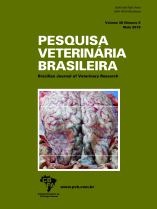 |
|
|
|
Year 2018 - Volume 38, Number 5
|

|
Control of gastrointestinal nematodes in sheep and financial analysis on a farm with irrigated rotational grazing system in the Brazilian semi-arid region, 38(5):913-919
|
ABSTRACT.- Vieira V.D., Riet-Correa W., Vilela V.L.R., Medeiros M.A., Batista J.A., Melo L.R.B., Santos A. & Riet Correa F. 2018. [Control of gastrointestinal nematodes in sheep and financial analysis on a farm with irrigated rotational grazing system in the Brazilian semi-arid region.] Controle de parasitas gastrintestinais em ovinos e análise financeira de uma fazenda com sistema de pastejo rotacionado irrigado no semiárido nordestino. Pesquisa Veterinária Brasileira 38(5):913-919. Programa de Pós-Graduação em Medicina Veterinária, Universidade Federal de Campina Grande, Avenida Universitária s/n, Jatobá, Patos, PB 58108-110, Brazil. E-mail: franklin.riet@pq.cnpq.br
The irrigated rotational grazing system is an alternative for sheep farming in the Brazilian semi-arid region. However, the mean limitation for its implementation is the difficulty to control gastrointestinal nematodes. The objective of this research was to determine management measures for the control of the gastrointestinal nematodes of sheep in irrigated rotational grazing and to perform the economic analysis of the system. The experiment was carried out on a farm in the Municipality of Belém do São Francisco, Pernambuco, from April 2013 to September 2014, in a herd of 646 to 859 crossbred Dorper x Santa Inês sheep, reared in an area of 12 hectares with coast cross (Cynodon dactylon) pastures divided into 24 paddocks. For grazing, the sheep were divided into two groups: one of lactating ewes and their lambs, and the other with non-lactating ewes and ewe hoggets older than two months. Both groups grazed three days in each paddock and each paddock lasted 36 days without being grazed. Antihelminth Fecal Egg Count Reduction Tests were performed at the beginning of the experiment and annually, resulting in the annual change of the drug used. In the second year, for fecal collections and for selective anthelmintic treatment, the ewes and the non-lactating sheep were divided into two subgroups each: fat and thin lactating ewes, and fat and thin non-lactating ewes. Each month, feces of 10% of the sheep of each subgroup were collected for egg counts and larval culture. Treatments were performed when the mean fecal egg counts were greater than 1000/g. Samples of grass were collected every two months to count and identify grass free-living Trichostrongylidae larvae. During the 18 months of study, approximately 3797 individual anthelmintic treatments were performed, equivalent to 6.49 treatments per sheep (3.97 in 2013 and 2.52 in 2014). The most prevalent helminth in coprocultures (50%-85%) and pasture (83.2%) was Haemonchus contortus. The lowest numbers of infective larvae in the pasture (94 to 111 larvae L3/kg DM) occurred on days 35 and 2 to 8 of grazing. The highest numbers occurred between days 17 to 20 (374 to 761 L3/kg DM). The meat production of the farm was 1023 kg per hectare and the profitability was 3.31%. It is concluded that grazing the paddocks for 3 days, with a rest of 36 days and using selective treatments, allows the control of gastrointestinal nematodes in irrigated rotational grazing systems. However, annual resistance tests are necessary to mitigate resistance of parasites to anti-helminths. |
| |
|
|
| |
|
 |